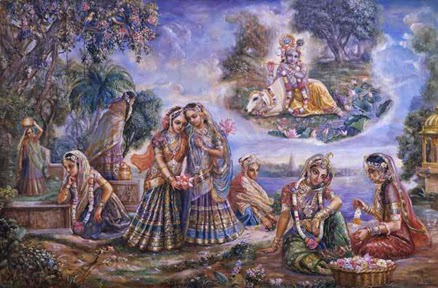 |
| The Three Lords - Brahma, Vishnu & Shiva |
According to the Arya Samaj, god is existent, intelligent,
blissful, formless, almighty, just, merciful, unborn, infinite, beginning less,
incomparable, the support and lord of all, omniscient, imperishable, immortal, fearless,
eternal, holy and maker of universe.
According to the core of Hinduism, he is infinite and exists
everywhere, in smallest of the particle to the whole universe in the form of
unknown energy which binds the whole universe and sustains it in the form as it
is present.
The main goal of life is to unite one's atma (conscious)
to that of parmatama (higher consciousness).
To do so there are many paths told- Karma yoga, Gyana yoga,
Kundalini yoga, Raj yoga, Hath yoga, Tantra yoga, Bhakti yoga.
All the above mentioned yoga forms except the last one
have become irrelevant in present world due to very drastic social, cultural,
religious and educational changes. The first step towards them is calm and
controlled mind achieved through meditation but nowadays continuous meditation
is very difficult for the common people.
That means only path that most common people can easily
follow is Bhakti yoga which is pure spiritual devotion, of love for God. To
love God unconditionally! In Bhakti yoga, everything is but a manifestation of
the divine and all else is meaningless, including the Ego. When the Bhakta is
blessed by divine grace he feels an undivided union and non-dual consciousness
prevails. Bhakti Yoga is regarded as the most direct method to merge in cosmic
consciousness. Bhakti yoga is based on the doctrine "Love is God and God
is Love". The bhakta experiences separation and longs to meet or even just
glimpse his beloved.
 |
| Lord Krishna |
Bhakti yog is of two types - Nirguna and Saguna.
Nirguna bhakti is directed towards the god which is
formless, infinite and having qualities which I have described earlier. Famous
saints of such category- Kabir and sages of ancient times
Saguna bhakti is practiced by directing your devotion
towards one of the manifestations of the almighty described above. This is practiced
mainly by common people in form of Rama, Krishna, Vishnu etc, as it is very
difficult to worship vacuum or something which is formless. Therefore Saguna
bhakti is performed by giving some form, shape, attributes, mythological
background to him. Famous saints of this category- Meera, Chaitanya Mahaprabhu,
Biharidas, Tulsidas etc.
It is said that a picture speaks more than thousand words;
people put the form which they have developed in their mind to the idols or
pictures they worship. Many feel Hinduism use stones or idols for worshipping.
It is a wrong assumption. Not only stones, whatever they find suitable they
carve or put it in the form they worship. For e.g. during Govardhana puja, it
is a tradition to worship Govardhan Parvat and Krishna. However the problem was
how to make or carve a parvat (mountain)? Carve it out of stone or draw it on a
paper to worship? In Haryana, almost every house in rural areas owns a cow. Hence
cow dung is easily available. So the people here build the image of Krishna and
the mountain with the dung on the floor and worship it. Now were those people
worshipping dung? No they were worshipping Krishna one of the manifestation of
that supreme conscious. Similar is the case with idols or portrait, they don't
worship the stone or paper; they worship the Saguna form of him.
 |
| Goddess Lakshmi, Goddess Durga & Goddess Saraswati |
How did their face and attire come in existence?
The forms in which gods are worshipped today are the
imagination of people who lived thousand years ago and which passed down from
generation to generation.
The main male gods worshipped are Shree Ram, Krishna,
Vishnu, and Shiva. Look closely you will see all of them having same facial
expression and features. Clothing’s and other attire depend on the mythological
background, powers and stories which revolve around them. All of them same
except Shiva have similar clothing’s and attire as were during ancient times. Shiva
is said to be living in natural surrounding therefore everything in his attire
is related with nature.
All the male gods and goddesses except few are identical
in looks. However each of them represents different attributes and
characteristics. Like Saraswati is goddess of learning, Lakshmi the Goddess of
wealth, etc. Difference is in their names, vehicles (vahana) and things they
hold in their hands, which are symbolic in nature.
How do people know that it is their gods face??
The answer is people themselves decide that which form is
close to their heart and what relationship they seek with him and also which
attribute they are drawn to. This is the beauty of Hinduism. It works on the
principle of “one size doesn't fit all”. People can worship him in any form and
in any relationship. Meera worshipped Krishna as her husband, Chaitanya as
master, Sudama as friend.




















